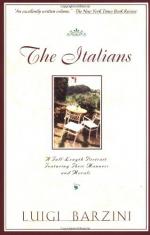Besides the festival, and Count Nobili’s audacity, the marchesa had a further cause for ill-humor. No one had come on that evening to play her usual game of whist. Even Trenta had deserted her. She had said to herself that when she—the Marchesa Guinigi—“received,” no other company, no other engagement whatever, ought to interfere with the honor that her company conferred. These were valid causes of ill-humor to any lady of the marchesa’s humor.
She was seated now in the sitting-room of her own particular suite, one of three small and rather stuffy rooms, on the second floor. These rooms consisted of an anteroom, covered with a cretonne paper of blue and brown, a carpetless floor, a table, and some common, straw chairs placed against the wall. From the anteroom two doors led into two bedrooms, one on either side. Another door, opposite the entrance, opened into the sitting-room.
All the windows this way faced toward the garden, the wall of which ran parallel to the palace and to the street. The marchesa’s room had flaunting green walls with a red border; the ceiling was gaudily painted with angels, flowers, and festoons. Some colored prints hung on the walls—a portrait of the Empress Eugenie on horseback, in a Spanish dress, and four glaring views of Vesuvius in full eruption. A divan, covered with well-worn chintz, ran round two sides of the room. Between the ranges of the graceful casements stood a marble console-table, with a mirror in a black frame. An open card-table was placed near the marchesa. On the table there was a pack of not over-clean cards, some markers, and a pair of candles (the candles still unlighted, for the days are long, and it is only six o’clock). There was not a single ornament in the whole room, nor any object whatever on which the eye could rest with pleasure. White-cotton curtains concealed the delicate tracery and the interlacing columns of the Venetian windows. Beneath lay the Moorish garden, entered from the street by an arched gate-way, over which long trails of ivy hung. Beautiful in itself, the Moorish garden was an incongruous appendage to a Gothic palace. One of the Guinigi, commanding for the Emperor Charles V. in Spain, saw Granada and the Alhambra. On his return to Lucca, he built this architectural plaisance on a bare plot of ground, used for jousts and tilting. That is its history. There it has been since. It is small—a city garden—belted inside by a pointed arcade of black-and-white marble.
In the centre is a fountain. The glistening waters shoot upward refreshingly in the warm evening air, to fall back on the heads of four marble lions, supporting a marble basin. Fine white gravel covers the ground, broken by statues and vases, and tufts of flowering shrubs growing luxuriantly under the shelter of the arcade—many-colored altheas, flaming pomegranates, graceful pepper-trees with bright, beady seeds, and magnolias, as stalwart as oaks, hanging over the fountain.




